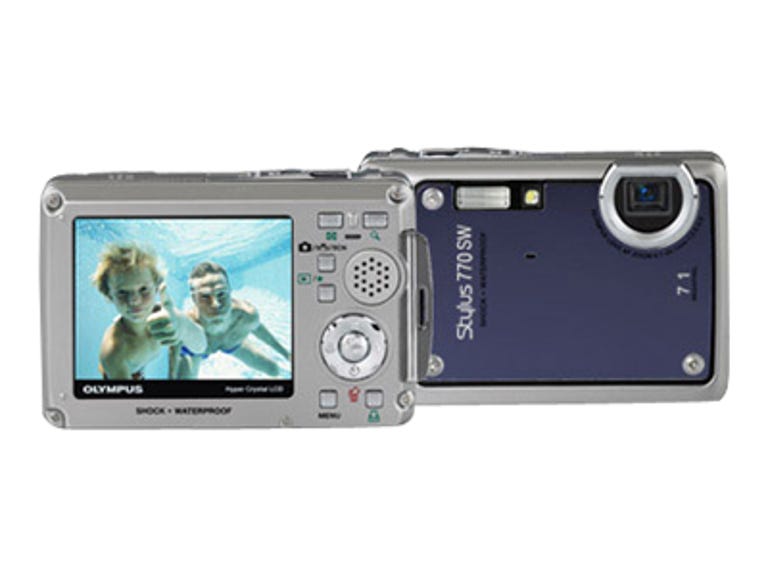 Why You Can Trust CNET
Why You Can Trust CNET Olympus Stylus 770SW review: Olympus Stylus 770SW
Olympus' Stylus 770SW might not produce perfect images, but you'd be hard pressed to find a compact camera as tough as this one.
There aren't many waterproof compact cameras out there, let alone one made to survive drops of up to 5 feet. Olympus designed its 7.1-megapixel Stylus 770SW to do just that, providing real competition for Pentax's waterproof Optio W30. By its tough nature alone, this Olympus makes an ideal choice if you routinely shoot in adverse conditions. I took it skiing with me as part of this review, and it fared better than I did on a couple of falls. In fact, despite three days of chilly temperatures and a lot of bumps, the Stylus 770SW still came out shooting.
The Good
The Bad
The Bottom Line
Obviously, a lot of credit should be given to this camera's solid construction. The 770SW weighs about 6.1 ounces with its battery and xD-Picture Card installed and measures 3.6x2.3x0.8 inches. It packs a 2.5-inch LCD, 3x optical, 38mm- to 114mm-equivalent f/3.5 to f/5.0 zoom lens, and a small 7.1-megapixel (effective) CCD sensor into its metal body.
The camera's small buttons were a bit difficult to press with heavy snow gloves on, but I did manage to snap off a few pictures in auto mode before removing my gloves. Like so many compact cameras, Olympus doesn't include manual exposure controls in the Stylus 770SW. To make up for that, the company includes auto and program modes, as well as 24 preset scene modes, so you can let the camera decide what to do based on the shooting conditions. Unfortunately, activating a scene mode requires two presses of a button on the camera back before you even get a chance to select the mode you want. This became somewhat frustrating over the course of three days skiing. Plus, since the movie mode is buried among the scene modes, you'll have to go through the same process if you want to capture a video clip. We'd prefer the option of letting the camera default to the scene mode you last used at start-up, or better yet, a dedicated scene mode button to jump into the last scene mode you used. Olympus' graphically driven menu system is plenty intuitive. Plus, commonly used functions, such as white balance and sensitivity, can be quickly changed by using the function/OK button found in the middle of the four-way rocker on the camera back.
Performance was somewhat slow in our tests. The Stylus 770SW took 2.1 seconds to start up and capture its first JPEG. Subsequent images took 2.4 seconds between shots with the flash turned off, jumping to 3.2 seconds between shots with the flash turned on. Shutter lag fared slightly better, measuring 0.6 second in our high-contrast test, but falling to 2 seconds in our low-contrast test. Continuous shooting mode yielded 1.1 frames per second when capturing VGA-sized JPEGs and 1.4 fps when capturing 7.1-megapixel JPEGs.
Images from the Stylus 770SW weren't perfect, but that's not surprising given this camera is built more for extreme durability than optical purity. For example, our test images looked slightly soft overall and had more image artifacts than we're used to in a camera in this price range, though you can't jump into a swimming pool and shoot images underwater with those cameras. Colors were generally accurate, though they seemed a bit undersaturated in places. Olympus keeps noise well under control through ISO 200. At ISO 400 noise due to sensitivity manifests itself as a light covering of off-color pixels (mostly bluish in nature), which robs a slight, but noticeable amount of sharpness from the image. At ISO 800, that off-color covering becomes heavier, reduces sharpness even more, and severely decreases shadow detail. At ISO 1600, all of those same problems become even worse. We suggest you stick to shooting below ISO 800 when possible, though higher ISOs may still yield acceptable 4x6-inch prints
(Seconds: smaller is better)
| Typical shot-to-shot time | Time to first shot | Shutter lag (typical) |
(Frames per second: larger is better)
